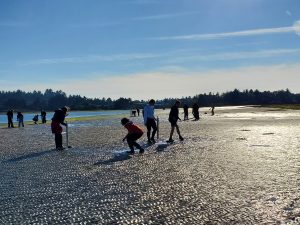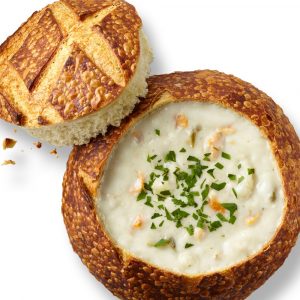Oregon Coast and Hatfield Science Center (October 12, 2023)
Mo’s Seafood and Chowder
Have you ever tried the famous “Mo’s clam chowder”? On our way to Hatfield Marine Science Center we had lunch at Mo’s which is famous for their clam chowder. However, they also had many different types of food to try and everyone ordered something else. Some ordered burgers, others pasta and some of us tried the famous clam chowder in a bread bowl.
Newport
After lunch at the Newport coast we were able to observe many sea lions. They were all lying on some floating boards at the docks of Newport: both next to each other and on top of each other. However, it was never quiet for a long time. As soon as one sea lion started making a sound, all the others did the same. The smell was different…everyone can decide for themselves whether it was good or bad. It smelled mostly like dead fish, which is also the food of the animals. In summary, I can say that visiting and observing the animals is definitely worth it, as you don’t see something like that every day.
Hatfield Marine Science Center
We went to the Marine Science Center to become familiar with marine life at the US West coast and to look at animals that live in these marine and beach areas. Hatfield serves as Oregon State University’s (OSU) coastal campus and as an oceanographic research base for six state and federal agencies. We arrived at 1pm and left at 5.30 pm and had lots of fun.
For some time we were allowed to explore the exhibitions on our own, observe many different sea animals, create our own Tsunami and try out the different activities offered. After that we went to the OSU’s special laboratories in the building. We examined different animals, such as sea stars, sea urchins, sea cucumbers and shrimp. We learned about the way they live, their adaptations to where they live and how and what they eat.
Next thing we went to the beach to catch some ghost shrimp and identify them. It was very muddy at the beach and you could easily sink into the mud/sand. We used so-called slurpers to suck out sand just like plungers and look for ghost shrimp in the mud. Sadly, some of them died while we sucked them out. However, the aim of the research is to gain a better understanding of these animals and of how to improve their protection. After only a few minutes we had dug out enough shrimp for our further investigations.
Back in the classroom we measured the shrimp, determined their gender and finally entered the data into excel sheets to illustrate the distribution of ghost shrimp according to age and sex. We not only learned a lot about ghost shrimps and their life but also about what it means to do research. All in all, it was a really nice and informative trip. If I had the chance to do so, I would definitely go there again.
(Alistair, Charlotte, Hanavi, Joana)



